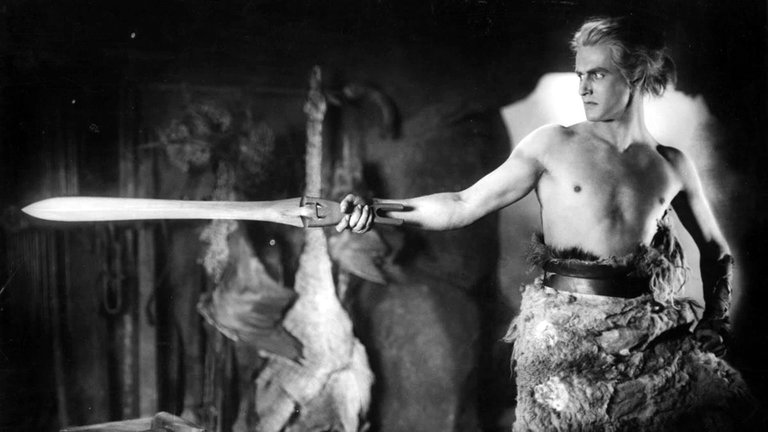
When nations appear to hit rock bottom, their people often try to find escape, comfort, or inspiration in a distant heroic mythical past. In the early 1920s, Germany was, following its defeat in the Great War, in such a situation, being affected by national humiliation, revolution, violence, hyperinflation, and other woes. The task of reminding Germans of their past glory was taken on by Erich Pommer, producer of Die Nibelungen (literally “The Nibelungs”), a 1924 fantasy epic directed by Fritz Lang, which is often considered one of the grand works of German silent cinema.
The film is based on the Nibelungenlied (or Song of the Nibelungs), a 13th-century German epic poem that represents a retelling of ancient Germanic myths dealing with events that took place roughly nine centuries earlier. This work has inspired many writers and artists, most notably the famous composer Richard Wagner, who adapted it into The Ring of the Nibelung, his renowned four-part opera cycle. The plot of Lang’s version begins with Siegfried of Xanten (played by Paul Richter), son of King Siegmund of Xanten, hearing tales about the Kingdom of Burgundy and its beautiful princess Kriemhild (played by Margarethe Schön). Determined to win her, Siegfried embarks on a journey during which he encounters a dragon, slays it, and bathes in its blood, which makes him invulnerable, except for a small spot accidentally covered by a leaf on his shoulder blade. His next obstacle is Alberich (played by Georg John), king of the Dwarves, from whom he acquires a net of invisibility and finds a large treasure. When he arrives at the Burgundian court, King Gunther (played by Theodor Loos), Kriemhild’s brother, promises the hand of his sister in exchange for helping him win the hand of Brunhild (played by Hanna Ralph), Queen of Isengaard, who has sworn that she will marry only a man who can defeat her in a threefold physical contest. Siegfried, using his net of invisibility, does so and later even impersonates Gunther to help him consummate his marriage. He marries Kriemhild, but she soon gets into conflict with her sister-in-law and inadvertently reveals Siegfried’s deception. Infuriated, Brunhild conspires with Gunther’s brother Hagen of Tronje (played by Hans Adalbert Schlettow) to have Siegfried murdered. When this happens, and when Kriemhild realises that her own family has murdered her husband, she accepts a marriage proposal from Lord Etzel (played by Rudolf Klein-Rogge), king of the Huns, hoping that he will help her exact terrible revenge.
Made by UFA, the studio that was becoming a powerhouse of European cinema at the time, Die Nibelungen represented one of the most ambitious German film projects of its era. Its ambition to serve as the country’s first proper cinematic epic can be seen in its formal dedication to “the German people.” Fritz Lang and his wife and screenwriter Thea von Harbou, partly inspired by Wagner’s approach to the source material more than half a century earlier, and partly aware of the problems the great length of almost five hours might pose, decided to split their film into two parts. The first part, titled “Siegfried,” is more interesting, at least to fans of the fantasy genre, because the plot features recognisable mythical creatures like dragons and dwarves, and there is more need for Lang to employ and experiment with various forms of special effects. Many of these special effects, quite understandably, look primitive from today’s perspective, but they represented first-class film techniques of their time, and some are impressive even today, like the large dragon, which was, due to the absence of credible miniatures or stop-motion animation, reconstructed using a life-sized model.
The second part, titled “Kriemhild’s Revenge,” is slightly different in terms of style and theme. It almost doesn’t feature any fantasy elements; it is more of a generic period piece and is rooted more in history than legend, with King Etzel a.k.a. Attila being a real-life figure. This part is also much darker, featuring the killing of children and ending with a prolonged battle that culminates in an apocalyptic and tragic outcome. “Kriemhild’s Revenge” also showcases Lang’s great effort to reconstruct the ancient Huns, making them appear more savage and exotic than the Burgundians, with their clean costumes and neat geometric patterns in architecture and decorations. However, the second part is much weaker because the pace is very slow, and the final showdown seems to go on forever, testing the patience of even some viewers who were accustomed to silent-era epics.
The acting in Die Nibelungen is solid, and the theatricality characteristic of many silent films is mostly subdued. However, Lang doesn’t appear to have much love for his actors, at least due to the absence of close-ups and an overreliance on wide shots that also make some of the events slightly confusing. Some of these flaws are, however, compensated by the epic score by Gottfried Huppertz, the composer who would later work with Lang on his science fiction classic Metropolis. In the end, Die Nibelungen became a massive hit and made Lang one of the most successful and influential filmmakers of his time. His film continued to inspire many filmmakers in the following decades, most notably Peter Jackson and his The Lord of the Rings trilogy.
RATING: 6/10 (++)
Blog in Croatian https://draxblog.com
Blog in English https://draxreview.wordpress.com/
InLeo blog https://inleo.io/@drax.leo
InLeo: https://inleo.io/signup?referral=drax.leo
Unstoppable Domains: https://unstoppabledomains.com/?ref=3fc23fc42c1b417
Hiveonboard: https://hiveonboard.com?ref=drax y
Bitcoin Lightning HIVE donations: https://v4v.app/v1/lnurlp/qrcode/drax
Rising Star game: https://www.risingstargame.com?referrer=drax
1Inch: https://1inch.exchange/#/r/0x83823d8CCB74F828148258BB4457642124b1328e
BTC donations: 1EWxiMiP6iiG9rger3NuUSd6HByaxQWafG
ETH donations: 0xB305F144323b99e6f8b1d66f5D7DE78B498C32A7
Posted using CineTV